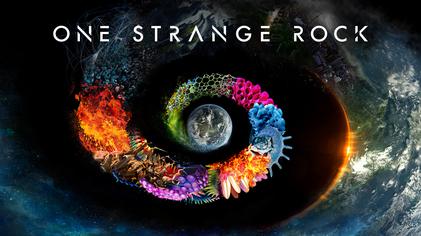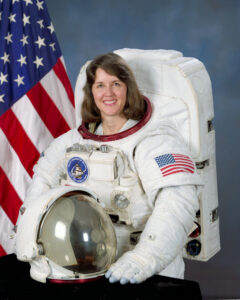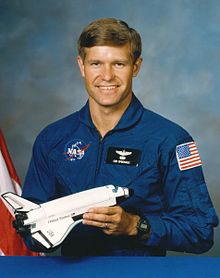The Thin Blue Line
The thin blue line refers to the edge of Earth's atmosphere. When you look out at a higher position (think International Space Station level), the light refracts to reveal an actual line where the atmosphere ends. It can be seen starting at about 35,000 feet up which means if you have ever flown in an airplane, you could have witnessed that blue line!
While I often refer to it as "the thin blue line" (mostly because it sounds so mystical!), the actual name is the Karman Line. The Karman Line sits at about 100 km up (63 miles) and is the official mark of outer space. This is really important when we talk about space policy and the Outer Space Treaty of 1967 which says no nation can "claim sovereignty" (own) outer space.
The atmosphere is made up of a lot of elements. Obviously, it has oxygen, the stuff we breathe every day. But the most abundant element is surprisingly nitrogen. Others include carbon dioxide, methane, neon, and so on. When we talk about the exosphere (the outermost layer of the atmosphere), helium and hydrogen are the main two elements.
While there is a lot of science behind the thin blue line, it holds a soft spot in my heart because of all the exciting metaphoric feelings it gives me.
I first heard the edge be referred to as the thin blue line years ago. Couldn't tell you when even if I wanted to. But recently, Netflix has a series called "One Strange Rock". It is amazing. Narrated by Will Smith, it looks at Earth and its issues while using interviews with astronauts. It is totally my kind of show! In the first episode, Astronaut Chris Hadfield discusses seeing the line for the first time. All those memories from when I was young (whenever I first heard of it) came back right when I was in a time in my life where I needed a new direction.
And that is when I decided that was my new life goal. To see the thin blue line for myself.
While I work on that mission... give me a few years... I have been continuing the inspiration. Every time I have met an astronaut, I ask them to recount their experience seeing the thin blue line. Here are their stories:

Born: August 29, 1959
From: Sarnia, Ontario, Canada
Mission: Shuttle program
Number of times in space: 3
Fun Fact: first Canadian commander of the ISS
Chris Hadfield
Okay so I haven't actually met Astronaut Chris Hadfield (yet) but he was the first astronaut that I heard talk about the thin blue line on Will Smith's "One Strange Rock" Episode 1. Even now, he talked about it with the most passion of all the astronauts I have asked. And I must confess, when I was desperate for a symbol for all my ideas and dreams in my head, I was watching the documentary and he inspired me. So thanks for all of this, Mr. Chris!

Kathryn Thornton
I met Astronaut Kathryn Thornton at Yuri's Night (celebrating the first man in space) and the Space Foundation. She had a broken arm and I had my foot in a boot from surgery still. We bonded over that and I gave her my "shark attack" line. She even remembered that two days later which made me feel pretty amazing. In answer to my question, Thornton said the thin blue line is "absolutely beautiful". Much to my surprise she also mentioned that it was neither as thin or blue as many expected. She explained that you can actually see the different layers and watch them make up the "thin blue line". Furthermore, she told me at "night", the line is more gray than blue and that you can actually "watch the stars behind it sink towards the earth". She spoke with excitement, explaining that it looks like the stars will collide with the earth but then you realize they are actually thousands of light years away. Nobody had explained it to me with that level of detail before. Truly, I just replay the video Astronaut Thornton outlined in my head over and over and over again.
Born: August 17, 1952
From: Montgomery, Alabama, US
Mission: Shuttle program
Number of times in space: 4
Fun Fact: one of the astronauts performing spacewalks to repair the Hubble telescope in 1993


Born: January 23, 1973
From: Louisville, CO, USA
Mission: Soyuz, International Space Station Operations
Number of times in space: 1
Fun Fact: retired from NASA to resume work serving the USA military in the Air Force.
Jack Fischer
Col. Jack Fischer was a surprise of an astronaut meeting. While at the 35th Space Symposium, I found myself in a networking event. While standing in the brisket line, a man in his Air Force uniform came up to me and said "I was told I needed to meet you by that man" (pointing at my boss). I was somewhat flustered and did not recognize the recently added astronaut until he mentioned he had been to space. When I asked him my question, Astronaut Fischer got almost as excited as me. He said he was completely mesmerized by the thin blue line and he just stared out the window when he first saw it. Fischer laughed at how his Russian cosmonaut companion had to give him a little nudge to pull him back to earth (figuratively of course). I related to Fischer very much as he was an easy guy to talk to. I hope to one day have the same "mesmerized" experience.
Bob Cabana
I met Bob Cabana as he was waiting to grab a shuttle to leave the 35th Annual Space Symposium. It was raining a bit so he luckily waited inside where I was able to meet him. He was very kind (as I am sure he had been dealing with fans all day). His reflection on the thin blue line was how indescribable it really was. And how it wasn't as thin as you would think. Cabana talked about at sunrise and sunset, the line becomes a rainbow of colors that get thicker and more vivid with more dust particles. He also talked about how when the sun is behind the earth, you literally can't see our planet, just where it is supposed to be. Which if you ask me is absolutely terrifying. So basically he said the thin blue line isn't always that thin and isn't that blue... but it is still one of the most amazing things to witness first hand.
Born: January 23, 1949
From: Minneapolis, MN, USA
Mission: Shuttle program
Number of times in space: 4
Fun Fact: has stayed incredibly involved with NASA including Lead Astronaut in the Shuttle Avionics Integration LAvoratory (SAIL), Chief of the Astronaut Office for NASA, Deputy Manager of the ISS Program, and Deputy Director of the Johnson Space Center.

Born: November 14, 1956
From: Portsmouth, VA, USA
Mission: Shuttle program
Number of times in space: 5
Fun Fact: also worked at SpaceX starting in 2009 as the Vice President of Astronaut Safety and Mission Assurance.

Ken Bowersox
I met Ken Bowersox at the Humans to Mars Summit 2019 in Washington DC. When he walked on stage, I thought he looked incredibly familiar... then they read his name and I thought "that's Luke's dad!" One of the kids I mentored in college through the ALC program had mentioned his dad was big in the space community. Didn't expect him to this big. We (Stardom Space) did a bit of an interview with him that I concluded by asking him about the thin blue line. Bowersox noted on the emotional feelings of seeing the line. He said it became amazingly clear to him that he was looking down at home. "Home" was the entire planet and we need to take care of it. All of us. He also talked about his last launch. He and his compatriots hit a bit of a rough patch on their way back down to earth and they ended up 2 hours away from their landing site. Bowersox said they got out and waited in the grass somewhere in Kazakhstan, watching the butterflies and calm winds. He reflected that here, on the other side of the world from the United States in a foreign country he had never visited, Bowersox felt the overwhelming comfort that he had come home. And to me, that is the beauty of space. It has the ability to bring together humanity.
Don McMonagle
Don McMonagle was the first astronaut who took the time to get to know me and led to a very personable interaction. It turns out McMonagle actually works for my company and has a part-time office almost directly below me, one floor down. All this time I had an astronaut under my nose! We talked a lot about his career (pilot to astronaut and after) as well as how he influences others still. Without getting too in-depth to our long talk, he gave me great insight into what it is like to see the thin blue line. McMonagle started by reliving a 4th grade memory of looking at a picture of the thin blue line in a textbook. He took out a ruler and verified (in true 4th grade fashion) that it was indeed curved. Flash forward: he was then the pilot of the shuttle and suddenly, through the large window, the edge of the atmosphere came into view. McMonagle said he was then pulled back to that photo all those years ago and had a moment of "yepp, looks just like my textbook!" What a personal and unique story to his past. I feel if I ever see it, I will have a similar experience of "yepp, that's it." McMonagle also talked about how he was fortunate enough to fly his spacecraft straight through the southern lights. He talked about how the green wavy lights were outside every window. Add that to my bucket list of things to see!

Born: May 14, 1952
From: Flint, MI, USA
Mission: Shuttle program
Number of times in space: 3
Fun Fact: also spent a few years working in Extra-Vehicular Activity (EVA) also known as spacesuits where he worked on enhancing current day EVAs as well as research and development for the next generation of spacesuits.